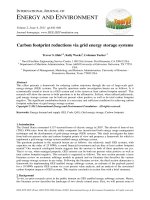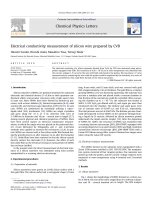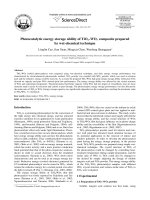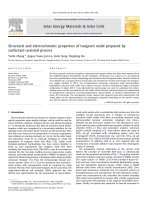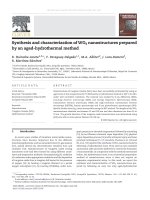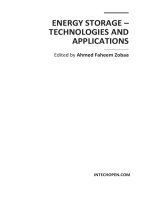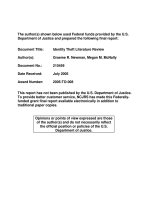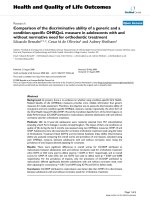- Trang chủ >>
- Khoa Học Tự Nhiên >>
- Vật lý
photocatalytic energy storage ability of tio2-wo3 composite prepared
Bạn đang xem bản rút gọn của tài liệu. Xem và tải ngay bản đầy đủ của tài liệu tại đây (682.26 KB, 6 trang )
Journal of Environmental Sciences 2010, 22(3) 454–459
Photocatalytic energy storage ability of TiO
2
-WO
3
composite prepared
by wet-chemical technique
Linglin Cao, Jian Yuan, Mingxia Chen, Wenfeng Shangguan
∗
Research Center for Combustion and Environment Technology, Shanghai Jiao Tong University, Shanghai 200240, China.
E-mail:
Received 15 June 2009; revised 05 August 2009; accepted 10 August 2009
Abstract
TiO
2
-WO
3
hybrid photocatalysts were prepared using wet-chemical technique, and their energy storage performance was
characterized by electrochemical galvanostatic method. TiO
2
powder was coupled with WO
3
powder, which was used as electron
pool and the reductive energy could be stored in. As a result, the prepared TiO
2
-WO
3
had good energy storage ability while pure TiO
2
showed no capacity and pure WO
3
showed quite low performance. The energy storage ability was affected by the crystal structure
of WO
3
and calcination temperature. The photocatalyst had better capacity when WO
3
had low degree of crystallinity, since its loose
structure made it easier for electrons and cations to pass through. The photocatalytic energy storage performance was also affected by
the molar ratio of TiO
2
to WO
3
. Energy storage capacity was significantly dependent on the composition, reaching the maximum value
at TiO
2
/WO
3
1:1 (mol/mol).
Key words: photocatalyst; TiO
2
-WO
3
; energy storage
DOI: 10.1016/S1001-0742(09)60129-7
Introduction
TiO
2
is a promising photocatalyst for the conversion of
the light energy into chemical energy, and has attracted
extensive attention for its application to water purification
(Herrmann, 1999), metal protection (Yuan and Tsujikawa,
1995), anti-bacterial (Rincon and Pulgarin, 2004), self-
cleaning (Rincon and Pulgarin, 2004) and so on. But it has
photocatalytic effect only under light illumination. There-
fore, researchers focus more on new photocatalysts, which
have energy storage ability and can have the photcatalytic
effect in dark condition. They combined photo-responsive
semiconductors (like TiO
2
or SrTiO
3
) (Tatsuma et al.,
2001; Ohko et al., 2002) with an energy storage material,
which has redox activity, and a more positive conduction
band potential than that of the photo-responsive semicon-
ductor in order to accept electrons from the irradiated
semiconductor (Tatsuma et al., 2001). WO
3
shows these
characteristics and can be used as an energy storage ma-
terial. Reductive energy (excited electrons) generated by
UV-irradiated photocatalyst can be stored in WO
3
, which
retains the reductive energy for a certain period even after
the light is turned off (Fig. 1) (Tatsuma et al., 2001, 2002).
The energy storage ability of TiO
2
/WO
3
thin film
photocatalyst was firstly reported by Fujishima and Tat-
suma (Tatsuma et al., 2001, 2003; Ohko et al., 2002;
Ngaotrakanwiwat and Tatsuma, 2004; Takahashi et al.,
* Corresponding author. E-mail:
2004). TiO
2
/WO
3
film was coated on the indium tin oxide
-coated (ITO-coated) glass plate and was applied to anti-
bacterial and anti-corrosion in darkness. The study works
showed that the interfacial contact state largely affected the
energy storage ability, and the crystal structure of WO
3
in TiO
2
/WO
3
film had great influence on its photo-charge
ability and the reversibility of the film (Ngaotrakanwiwat
et al., 2003; Higashimoto et al., 2005, 2007).
TiO
2
photocatalyst powder used for interior and exte-
rior wall paint has attracted much attention because of
its potential application in the removal of indoor and
outdoor pollution. In order to develop the photocatalyst
paint having the energy storage property, in the present
work, TiO
2
-WO
3
powder was prepared using simple wet-
chemical technique. The crystal structure of WO
3
of
the photocatalyst could be changed by controlling heat-
treatment temperature during sample preparation, and the
molar ratio of WO
3
to TiO
2
could also be changed to
the desired by simply adjusting the dosage of soluble
tungstic acid and TiO
2
powder. The energy storage ability
of the TiO
2
-WO
3
photocatalyst samples with different
WO
3
crystal structure and various molar ratio of WO
3
to
TiO
2
were evaluated.
1 Experimental
1.1 Preparation of TiO
2
-WO
3
powder
Soluble tungstic acid solution was first made using
No. 3 Photocatalytic energy storage ability of TiO
2
-WO
3
composite prepared by wet-chemical technique 455
Fig. 1 Energy storage mechanism of TiO
2
-WO
3
photocatalyst.
cation-exchange technique (Choi et al., 2002; Zou, 2005).
Na
2
WO
4
·2H
2
O (AR, Sinopharm Chemical Reagent Co.,
Ltd., China) was dissolved into de-ionized water and
formed 0.25 mol/L aqueous solution of sodium tungstate.
The aqueous solution was then let to flow down at a certain
rate through the glass column packed with protonated
cation-exchange resin.
Soluble tungstic acid solution was dried at 80°C into
solid state, and ground into powder which was marked as
W-0. Then the W-0 sample was heat-treated for 2 hr under
different temperatures (150, 250, 350, 450, 550°C), and the
heat-treated samples were in turn marked as W-150, W-
250, W-350, W-450, W-550, respectively.
TiO
2
powder (P25, Degussa), at a certain molar ratio of
Ti to W, was put into the soluble tungstic acid solution
prepared as above, along with stirring. Then the well-
distributed suspension was dried at 80°C, and ground into
powder which was then marked as TixWy-0 (x:y equals
the molar ratio of TiO
2
to WO
3
). TiW-0 sample was
also heat-treated with same condition as W-0. And the
samples heat-treated at different temperatures were in turn
marked as TixWy-150, TixWy-250, TixWy-350, TixWy-
450, TixWy-550.
1.2 Characterization
The XRD patterns were obtained using an X-ray diffrac-
tometer (D/max-2200/PC, Riguku, Japan) with Cu K
α
radiation in a scan range of 15–45
◦
and a scan speed of
2
◦
/min operated at 40 kV and 20 mA; UV-Vis spectroscop-
ic measurement in diffuse reflectance mode were carried
out using a UV-Vis double-beam spectrophotometer (TU-
1901, Beijing Purkinje General Instrument, China) with
a Ulbricht sphere (Radius; 60 mm) from 230 to 850 nm.
For measurement of UV-Vis absorption spectra, a pressed
piece of BaSO
4
was used as reference; Te Brunauer-
Emmett-Teller (BET) surface area was measured from
N
2
adsorption method on Quantachrome NOVA 1000-
TS (USA); The TEM was recorded on JEM-2010/INCA
OXFORD Analytical Transmission Electron Microscope
(JOEL, Japan; Oxford, U.K.). Thermogravimetric analyses
(TGA) were carried out with a TGA 2050 (TA, USA) at a
heating rate of 15°C/min under air.
1.3 Measurement of photocatalytic activity
The ability of photocatalytic energy storage was
measured by electrochemical galvanostatic method, using
three pole system of Pt auxiliary electrode, SCE reference
electrode and working electrode of TiO
2
-WO
3
photocata-
lyst powder.
The working electrode of TiO
2
-WO
3
powder was pre-
pared as follows. The TiO
2
-WO
3
powder was mixed with
ethanol and ground to form slurry, and then the slurry was
spread on a conductive indium tin oxide glass (ITO, 2 cm ×
2.5 cm) by squeegee method (Smestad and Gratzel, 1998),
followed by thermal treatment at 80°C for 2 hr in air. The
mass of ITO glass was measured both before and after
coating. The net weight of photocatalyst powder, which
was coated onto ITO glass, was measured. For one kind
of TiO
2
-WO
3
powder sample, several working electrodes
were prepared.
All working electrodes of photocatalysts above were
photo-charged in 3 wt.% NaCl electrolyte solution (pH
5) for 60 min with 350 W-Xe lamp (Spherical Xenon
Lamp, Shanghai DianGuang Device Co., Ltd., China).
Discharge ability of those photo-charged photocatalysts
on working electrodes were measured by electrochemical
galvanostatic method with a speed of 2 μA/min in the three
pole system. The discharge ability of unit mass sample was
then calculated.
2 Results and discussion
2.1 Structure and physicochemical property of TiO
2
-
WO
3
Figure 2 shows the thermal gravimetric analysis (TGA)
of as dried W-0 and Ti
1
W
1
-0 solid at a heating rate of
15°C/min in air atmosphere in the temperature range of
40–800°C. The TGA curve of W-0 sample showed the
mass losses below 270°C, which was due to the release of
absorbed water and the decomposition of tungsten oxide
hydrate. It indicated that decomposition of tungsten oxide
hydrate all occurred below 270°C and only tungsten oxide
existed after being treated over 270°C. The TGA curves of
as dried Ti
1
W
1
-0 sample generally showed the mass losses
below 240°C, indicating that decomposition of tungsten
oxide hydrate was completed under 240°C.
XRD patterns of pure WO
3
samples are shown in Fig.
3a. The sample calcinated at 150°C generally consists
of tungsten oxide hydrate and some monoclinic WO
3
.
The sample calcinated at 250°C mainly contains WO
3
456 Linglin Cao et al. Vol. 22
Fig. 2 TG curves of solid-state samples W-0 and Ti
1
W
1
-0 which was
dried at 80°C.
which has quite low degree of crystallinity. With thermal
temperature rising, the crystallinity degree increased.
XRD patterns of TiO
2
-WO
3
(1:1, mol/mol) samples are
shown in Fig. 3b. It shows that the peak intensity of WO
3
in TiO
2
-WO
3
increases with calcination temperatures in-
creasing from 150 to 550°C, being in agreement with pure
WO
3
shown in Fig. 3a. No phase transformation of TiO
2
occurred in all TiO
2
-WO
3
samples prepared in the process,
and the TiO
2
in all samples had the same phase structure
of anatase.
In order to investigate the photo absorption perfor-
mance of TiO
2
-WO
3
, the UV-Vis absorption spectra of
1:1 (mol/mol) TiO
2
-WO
3
samples calcinated at various
temperatures was measured. As a comparison, the spectra
of P-25 (TiO
2
) was also measured and shown together
in Fig. 4. Compared with P-25, the absorption edges of
all TiO
2
-WO
3
samples shifted to longer wavelength. The
absorption edges of TiO
2
-WO
3
calcinated from 250 to
550°C are around 490 nm, which is in agreement with
pure WO
3
. The adsorption edge (520 nm) of TiO
2
-WO
3
calcinated at 150°C is attributed to the tungsten oxide
hydrate.
The specific surface area (SSA) of TiO
2
-WO
3
samples
with different thermal temperature was measured. As
Fig. 4 Diffuse reflection spectra of P25, and 1:1 (mol/mol) TiO
2
-WO
3
samples which were heat-treated for 2 hr at different temperatures (150,
250, 350, 450, 550°C).
Table 1 Specific surface area (SSA) of TiO
2
-WO
3
samples
heat-treated for 2 hr at different temperatures
SSA (m
2
/g) 150°C 250°C 350°C 450°C 550°C
1:1 (mol/mol) 21 25 21 18 16
TiO
2
-WO
3
2:1 (mol/mol) 18 23 23 20 20
TiO
2
-WO
3
shown in Table 1, the SSA showed a slight variation with
calcination temperature.
Micrographs of pure WO
3
and TiO
2
-WO
3
samples were
investigated by TEM measurement. TEM image of WO
3
samples in Fig. 5a indicated that WO
3
generally formed
large particles in square shape and was accompanied with
a bit small particles. From TEM images and EDS analysis
results shown in Fig. 5 b–d, it seemed that TiO
2
particles
were stuck on the surface of WO
3
and formed a contact
interface between them.
2.2 Energy storage performance
The energy storage capacity of TiO
2
-WO
3
samples with
different heat-treatment temperature is shown in Fig. 6.
Single TiO
2
did not have energy storage performance
while single WO
3
had quite low energy storage capacity.
Fig. 3 XRD patterns of pure WO
3
(a) and 1:1 (mol/mol) TiO
2
-WO
3
samples (b), respectively heat-treated for 2 hr at different temperatures (150, 250,
350, 450, 550°C).
No. 3 Photocatalytic energy storage ability of TiO
2
-WO
3
composite prepared by wet-chemical technique 457
Fig. 5 TEM image of pure WO
3
and TiO
2
-WO
3
samples, and EDS spectrum images of TiO
2
-WO
3
samples, The unlabeled peaks are adventitious
carbon and copper. (a) WO
3
; (b) 5:1 (mol/mol) TiO
2
-WO
3
; (c) 1:1 (mol/mol) TiO
2
-WO
3
; (d) 1:3 (mol/mol) TiO
2
-WO
3
.
458 Linglin Cao et al. Vol. 22
Fig. 6 Energy storage capacity of pure WO
3
, 1:1 (mol/mol) TiO
2
-
WO
3
and 2:1 (mol/mol) TiO
2
-WO
3
samples heat-treated for 2 hr at
different temperatures (150, 250, 350, 450, 550°C), compared with the
performance of pure TiO
2
.
By comparison, TiO
2
-WO
3
samples showed much more
energy storage capacity than sum capacity of TiO
2
and
WO
3
, which evidently indicated the energy storage ability
of hybrid TiO
2
-WO
3
samples. It also could be found that
TiO
2
-WO
3
samples treated at 250°C have best energy
storage ability while other samples have less capacity.
Generally, main reaction of energy storage goes in three
steps: generation of photo-electrons, storage of photo-
excited electrons and the release of storage electrons
(Tatsuma et al., 2001).
TiO
2
+ hν—— h
+
+ e
-
(1)
WO
3
+ xe
-
+ xNa
+
—— Na
x
WO
3
(2)
Na
x
WO
3
——WO
3
+ xe
-
+ xNa
+
(3)
First, electrons in TiO
2
valence band are excited to the
conduction band under UV irradiation. Then, the photo-
excited electrons are transferred and injected to WO
3
(Nenadovic et al., 1984; Tada et al., 2004), because it has a
more positive conduction band than TiO
2
, and the electrons
are then stored by WO
3
along with a redox reaction. After
the UV light is turned off, the stored electrons are released,
and they can react just as the photo-electrons do.
For all TiO
2
-WO
3
samples treated below 550°C in this
work, when the molar ratio of TiO
2
to WO
3
(x:y)was
fixed, samples had same amount of TiO
2
. Because the TiO
2
had same crystal structure which could be known from
XRD analysis, the generation of photo-electrons by TiO
2
in the first step went in the same way. Thus, the difference
of energy storage ability was attributed to the different
electron-storage ability of samples, which was affected by
the crystal structure of WO
3
.
As known from Eq. (2), the photo-electrons and Na
+
transferred within channels of WO
3
or entered into its
frame. The crystal structure of WO
3
was monoclinic and
it belonged to the pseudo-cubic ReO
3
type (Solonin et
al., 2001). It could be represented as continuous frame
constructed from [WO]
6
octahedron which was linked by
corner sharing oxygen atom, and the arrangement results in
a simple cubic symmetry. Within the frame, there existed
outspread tunnels which could be used as circulation
channel or embedded position for ions.
TiO
2
-WO
3
heat-treated at 150°C contained tungsten
oxide hydrate which could not store electrons. Thereby,
it had correspondingly less energy storage capacity. TiO
2
-
WO
3
heat-treated at 250°C mainly consisted of WO
3
which had low degree of crystallinity. Within the structure,
there existed [W-O] polygonal tunnels with large size and
distorted structures channel formed by oxygen vacancy.
It formed a comparatively loose structure. This made it
quite easy for photo-electrons and Na
+
to transfer and
store electrons, resulting in better energy storage ability.
TiO
2
-WO
3
samples heat-treated at higher temperature had
higher crystallization degree of WO
3
. The structure tunnel
became small and compact, and this made it difficult for
ions and electrons to transfer or enter into. This resulted
in worse energy storage ability. When WO
3
was applied
to electrochromics, it had the similar behavior of the per-
formance changing with its crystallization degree (Chen et
al., 1991). It concluded that the excellent energy storage
ability of TiO
2
-WO
3
heat-treated at 250°C resulted from
the WO
3
crystal phase and its low degree of crystallinity.
To observe the influence of molar ratio of TiO
2
to WO
3
on photocatalytic energy storage performance, TiO
2
-WO
3
samples with various molar ratios were heat-treated at
250°C. As shown in Fig. 7, the molar ratio of TiO
2
to
WO
3
has influence on the performance. Pure TiO
2
had
no capacity, and pure WO
3
had quite low capacity. The
TiO
2
-WO
3
photocatalyst samples had a best capacity when
molar ratio of TiO
2
to WO
3
was 1:1, and had lower
capacity with either larger or smaller ratio. This could be
explained by the different function of TiO
2
and WO
3
(Tat-
suma et al., 2001, 2002; Takahashi et al., 2004). TiO
2
acts
an electron generator to supply photo-generated electrons
under irradiation, while WO
3
plays the role of electron
receiver which determines the quantity of electrons re-
ceived and stored. So the molar ratio of WO
3
to TiO
2
would affect the utilization efficiency of TiO
2
and WO
3
,
and have influence on the quantity of stored electrons
which determined materials’ energy storage performance.
Besides, the storage of photo energy is achieved through
Fig. 7 Energy storage capacity of pure WO
3
and TiO
2
-WO
3
sam-
ples with different TiO
2
/WO
3
molar ratio, which were heat-treated at
250°C for 2 hr, compared with the energy storage capacity of P25.
No. 3 Photocatalytic energy storage ability of TiO
2
-WO
3
composite prepared by wet-chemical technique 459
the transfer of photo-generated electrons from TiO
2
to
WO
3
(Nenadovic et al., 1984; Tada et al., 2004). Therefore,
it is necessary for excellent photocatalysts with energy
storage ability to have suitable ratio of TiO
2
/WO
3
and good
contact between TiO
2
and WO
3
.
3 Conclusions
TiO
2
-WO
3
photocatalyst powder samples have been
successfully made from soluble tungstic acid and TiO
2
powder by wet-chemical technique. The crystal structure
of WO
3
could be changed through changing heat-treatment
temperature. Molar ratio of TiO
2
to WO
3
was changed
via adjusting the dosage of soluble tungstic acid and TiO
2
powder.
The prepared TiO
2
-WO
3
photocatalyst showed energy
storage ability in electrochemical measurement while pure
TiO
2
showed no capacity and pure WO
3
was low. The
energy storage ability of TiO
2
-WO
3
was dependent on the
crystal structure of WO
3
and the molar ratio of WO
3
/TiO
2
.
When sample was composed of TiO
2
-WO
3
in 1:1 molar
ratio and was heat-treated at 250°C, it gave the best the
energy storage ability. This might be attributed to the loose
structure of WO
3
crystal phase, which might be helpful to
the electrons transfer during the process of photocatalytic
energy storage.
Acknowledgments
The work was supported by the National Basic Research
Program of China (973 Program) (No. 2007CB613305),
the National High Technology Research and Development
Program of China (863 Program) (No. 2007AA061405)
and the Special Foundation of Nanometer Technology
(No. 0752nm005) from Shanghai Municipal Science and
Technology Commission (STCSM) of China.
References
Chen A, Zhang W M, Hitchcock D C, 1991. The electrochromic
properties of sol-gel electrophoresis film WO
3
. Journal of
the Chinese Ceramic Society, 19(3): 220–225.
Choi Y G, Sakai G, Shimanoe K, Miura N, Yamazoe N, 2002.
Preparation of aqueous sols of tungsten oxide dihydrate
from sodium tungstate by an ion-exchange method. Sensor
Actuators B: Chemical, 87(1): 63–72.
Herrmann J M, 1999. Heterogeneous photocatalysis: fundamen-
tals and applications to the removal of various types of
aqueous pollutants. Catalysis Today, 53(1): 115–129.
Higashimoto S, Kitahata N, Mori K, Azuma M, 2005. Photo-
electrochemical properties of amorphous WO
3
supported
on TiO
2
hybrid catalysts. Catalysis Letters, 101(1-2):
49–51.
Higashimoto S, Shishido T, Ohno Y, Azuma M, Takahashi M,
Anpo M, 2007. Photocharge-discharge behaviors of hybrid
WO
3
/TiO
2
film electrodes – Conversion, storage of elec-
trons, and the effect of the WO
3
structure on rechargeability.
Journal of the Electrochemical Society, 154(2): 48–54.
Nenadovic M T, Rajh T, Micic O I, Nozik A J, 1984. Electron
transfer reactions and flat-band potentials of WO
3
colloids.
Journal of Physical Chemistry, 88(24): 5827–5830.
Ngaotrakanwiwat P, Tatsuma T, 2004. Optimization of energy
storage TiO
2
-WO
3
photocatalysts and further modification
with phosphotungstic acid. Journal of the Electroanalytical
Chemistry, 573(2): 263–269.
Ngaotrakanwiwat P, Tatsuma T, Saitoh S, Ohko Y, Fujishima
A, 2003. Charge-discharge behavior of TiO
2
-WO
3
pho-
tocatalysis systems with energy storage ability. Physical
Chemistry Chemical Physics, 5: 3234–3237.
Ohko Y, Saitoh S, Tatsuma T, Fujishima A, 2002. SrTiO
3
-
WO
3
photocatalysis systems with an energy storage ability.
Electrochemistry, 70: 460–462.
Rincon A G, Pulgarin C, 2004. Bactericidal action of illuminated
TiO
2
on pure Escherichia coli and natural bacterial con-
sortia: post-irradiation events in the dark and assessment
of the effective disinfection time. Applied Catalysis B-
Environmental, 49: 99–112.
Smestad G P, Gratzel M, 1998. Demonstrating electron transfer
and nanotechnology: A natural dye-sensitised nanocrys-
talline energy converter. Journal of Chemical Education,
75(6): 752–756.
Solonin Y M, Khyzhun O Y, Graivoronskaya E A, 2001. Non-
stoichiometric tungsten oxide based on hexagonal WO
3
.
Crystal Growth & Design, 1(6): 473–477.
Tada H, Kokubu A, Iwasaki M, Ito S, 2004. Deactivation of
the TiO
2
photocatalyst by coupling with WO
3
and the
electrochemically assisted high photocatalytic activity of
WO
3
. Langmuir, 20(11): 4665–4670.
Takahashi Y, Ngaotrakanwiwat P, Tatsuma T, 2004. Energy
storage TiO
2
-MoO
3
photocatalysts. Electrochimica Acta,
49(12): 2025–2029.
Tatsuma T, Saitoh S, Ngaotrakanwiwat P, Ohko Y, Fujishima A,
2002. Energy storage of TiO
2
-WO
3
photocatalysis systems
in the gas phase. Langmuir, 18(21): 7777–7779.
Tatsuma T, Saitoh S, Ohko Y, Fujishima A, 2001. TiO
2
-WO
3
photoelectrochemical anticorrosion system with an energy
storage ability. Chemistry of Materials, 13(9): 2838–2842.
Tatsuma T, Takeda S, Saitoh S, Ohko Y, Fujishima A, 2003.
Bactericidal effect of an energy storage TiO
2
-WO
3
photo-
catalyst in dark. Electrochemistry Communications, 5(9):
793–796.
Yuan J N, Tsujikawa S, 1995. Characterization of sol-gel-derived
TiO
2
coatings and their photoeffects on copper substrates.
Journal of the Electrochemical Society, 142: 3444–3450.
Zou L X, 2005. Synthesis of the Nano-WO
3
with high specif-
ic surface area and its photocatalytic activity to degrade
gaseous formaldehyde. In: Chemical Engineering and Tech-
nology. Nanjing University of Science and Technology.
Nanjing, China.
